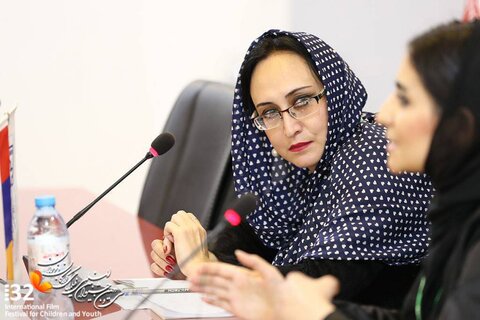Iran (IMNA) - At the workshop, the Armenian filmmaker Anush Babayan elaborated on her experience and the course of getting acquainted with the Iranian films, particularly those made by the two prominent directors Abbas Kiarostami and Majid Majidi.
The session was attended by a number of young filmmakers and foreign guests.
Iran a pioneer in cinema industry
She said that she had made enormous efforts over the past years to get access to the distinguished films of Iranian directors, such as Cow made by Dariush Mehrjoui.
Describing “the long history of the Iranian cinema” as noteworthy, the filmmaker said, “Only a few years after the Lumiere brothers invented the cinematograph, Iran’s cinema was born.”
“Attention to the industry by my Iranians is of great importance, as there were only few countries in the world that were interested in cinema,” Babayan said.
Referring to the theatre and cinema school that was founded in Iran in 1904 by Ovanes Ohanian, she said, “The first talking film of the Iranian cinema was made in 1934 putting the country on the same ranking with Germany and the US.”
The filmmaker said that two Iranian films, namely Qeysar made by Masoud Kimiai and Cow by Mehrjoui caught her attention when she was delving into the modern era of cinema in countries all around the world.
“No country would progress to a decent status overnight, but a correct solid foundation can ease the progress in the future,” she explained.
In the 1960s, she said, Iran’s national television was founded, and a few years later the festival for children began to be held in the country.
“A move that was rare in the entire world,” Babayan hailed Iran’s leading role in the field.
Majidi and Kiarostami gave new life to Iran’s cinema
Nearly 10 years after the Islamic Revolution, she noted, Iran’s cinema underwent a rebirth that was accompanied by the works of the two prominent filmmakers: Kiarostami and Majidi.
Both filmmakers began their careers with films focused on children, she said adding that Kiarostami’s works were made during the time he was at Iran’s Institute for Intellectual Development of Children and Young Adults.
The films were reminiscent of the acclaimed French filmmaker Jean Vigo’s Zero For Conduct, Babayan said of Kiarostami’s short films.
She praised Kiarostami’s choice of actors and the scenes focused on children’s eyes when they are expressing their feelings when they are tearful.
Another admirable characteristic of Iranian acting is the lack of distracters that make the viewers concentrate on their faces mimic due to their appearance, she argued.
Emotions characterizes Majidi’s films
Speaking on Majidi’s style, she said that the Iranian director knows well how to work with the actors and has a particular style, much similar to the social realism.
Referring to the ubiquitous scenes of running in Majidi’s films, Babayan said such scenes denote the characters’ internal feelings that make the films much more impressive.
“Characters and heroes in Majidi’s film, or maybe in all Iranian-made films, are characterized by being overwhelmed by sense of sacrifice, love of family, conscientiousness and values that seems to be never outdated,” she said.
“Love, including the type found between sisters and brothers, or a father and his son, are portrayed in Majidi’s film,” the Armenian filmmaker said.
The short film God Will Come, is an outstanding film made by Majidi, she said adding that the film left a strong impression on her and her son.
“It is acknowledged, not only by me but also by many experts, that Iranian cinema is of a unique style,” she said.
Kiarostami’s works wrapped in philosophy
“If Majidi is seen as a filmmaker who lives with his films’ characters on the earth, Kiarostami is considered to have a view that is philosophical as he tried to express his sense of loneliness through his films,” she said.
Heroes in Kiarostami’s kids films are more creative, smarter and even more romantic than the child characters of Majidi’s films, she maintained.
The Koker trilogy of the Iranian filmmaker is of great status in his films, she said adding that Kiarostami’s seemed to make efforts to embed films within other films.
He was not afraid of choosing a common place topic for his films, the Armenian film maker said.
“In the movie Through the Olive Trees, Kiarostami could manage to correctly link the love between lovers to the tragedy of the earthquake in the northern Iran,” she said.
Statistics show that some 130 films are annually produced in Iran, Babayan said comparing the figure with her own country which has been trying to pass through restructuring after the fall of the Soviet Union.
Referring to the co-production of Iran and Armenia, Yeva, made by Anahid Abad, she said that Yerevan welcomes more cooperation with Iran in the field of co-production.
The 32nd edition of the International Film Festival for Children and Youth is under way in Isfahan. The cinematic event was officially opened on Monday August 19 and will be wrapped up on August 26.
Seventy-eight foreign guests from 27 countries are participating in different sections of the festival.


Your Comment